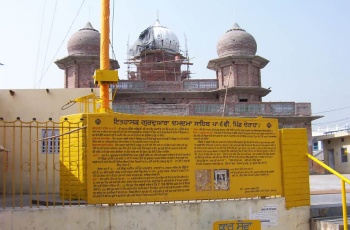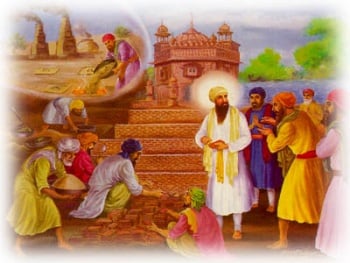Dasvandh
| Part of a series on Sikh Practices |
| Sikhism |
| Sanskar |
| Sikh rites |
| Personal 5 Banis . Five ks |
Dasvandh or Dasaundh, literally means a "tenth part" and refers to the practice among Sikhs of contributing in the name of the Guru, one-tenth of their earnings towards the common resources of the community. This is also referred to in Punjabi as "Daan" literally "giving" or "contributing" in charity. This is a Sikh's religious obligation — a religious requirement or duty; a form of seva or humble service which is highly valued in the Sikh system. The concept of dasvandh was implicit in Guru Nanak Dev Ji’s own Gurbani in the line: "ਘਾਲਿ ਖਾਇ ਕਿਛੁ ਹਥਹੁ ਦੇਇ ॥ ਨਾਨਕ ਰਾਹੁ ਪਛਾਣਹਿ ਸੇਇ ॥੧॥ One who works for what he eats, and gives some of what he has - O Nanak, he knows the Path (1)" (SGGS p 1245) The idea of sharing and giving is symbolised by the institutions of langar (community kitchen) for the sangat (holy assembly) that the Guru has established.
Background

In the time of Guru Amar Das Ji, Nanak III, a formal structure for channelizing Sikh religious giving was evolved. He set up 22 manjis or districts in different parts of the country, each placed under the charge of a pious Sikh who, besides preaching Guru Nanak Dev Ji’s word, looked after the sangats within his/her jurisdiction and transmitted the disciple’s offerings to the Guru.
As the digging of the sacred pool at Amritsar, and the erection in the middle of it of the shrine, Sri Harimander sahib, began under Guru Ram Das Ji entailing large amounts of expenditure, Sikhs were enjoined to set apart a minimum of ten per cent (dasvandh) of their income for the common pool, Guru key Golak or just "Golak". Masands, i.e. ministers and the tithe-collectors, were appointed to collect "kar bhet" (offerings) and dasvandh from Sikhs in the area they were assigned to, and pass these on to the Guru.
The custom of dasvandh was codified in documents called rahitnamas, manuals of Sikh conduct, written during the lifetime of Guru Gobind Singh or soon after. For example, Bhai Nand Lal’s Tankhahnama records these words of Gobind Singh: “Hear ye Nand Lal, one who does not give dasvandh and, telling lies, misappropriates it, is not at all to be trusted.” The tradition has been kept alive by chosen Sikhs who to this day scrupulously fulfil the injunction. The institution itself serves as a means for the individual to practice personal piety as well as to participate in the ongoing history of the community, the Guru Panth.
Parallels in other Religions
Dasvandh has since become part of the Sikh way of life. The custom bears parallels to Christian tithes requiring members of the church to pay a tenth part of the annual produce of their land or its equivalent in money to support it and the clergy, and to Muslim zakat requiring assignment of 2.5 per cent of one’s annual wealth for the welfare of the destitute and the needy. Classical Indian society had no set procedure for regulating donations or charities, though references are traceable such as those in Parasar Rishi’s writings urging the householder to reserve 1/21 part of his income for Brahmans and 1/31 part for the gods. The Upanisads and the Bhagavadgita commend “true alms” given with a sense of duty in a fit place and at a fit time to a deserving person from whom one expects nothing in return. Dasvandh is, however, to be distinguished from dan or charity. It essentially attends to the needs of the community and contributions are made specifically for the maintenance of its religious institutions such as gurdwaras and guru ka langar and projects of social welfare and uplift.
See Also
- Cash and Trash - This is a very revealing tale about giving in Charity which gives a potent message to be aware of: "A close friend, a university professor at Ludhiana, narrated this episode to me about two decades ago. I repeat below what my friend described to me:
You know, I contribute regularly for Gurdwara functions. Once, special Gurpurb celebrations were arranged by the campus residents of the Panjab Agriculture University, Ludhiana. The organizers as usual visited me for my contributions. I usually gave 25 rupees every time they came for collections. They told me, “This will be a special function, we want bigger contributions this time. Mr. A (a clerk) paid 20 rupees.” This was a signal for me to double my contributions. However, keeping my recent promotion and position at the University in mind, I contributed one hundred rupees. The members were very pleased since they expected only 50 rupees. Continued…...
- SGGS on Charity - This article list some relevant Shabads that are connected to giving in Charity: "My mind is imbued with the Lord's Love; it is dyed a deep crimson. Truth and charity are my white clothes. The blackness of sin is erased by my wearing of blue clothes, and meditation on the Lord's Lotus Feet is my robe of honor." Continued....
Detailed Explanation
Dasvandh (or Daswand) - Giving one tenth of your income (10%) is a practice of recognizing that every thing comes from God the Giver. One tenth of your income should be given back to God, the giver. This demonstrates your recognition that your income comes to you from God and therefore, your giving back one tenth to the Giver, demonstrates your faith and devotion this Giver. This giving is a seed. It is a seed of trust that actually has the effect of multiplying your income just as a seed sprouts and grows into more plants. It is a principle called tithing. Many religious groups do this and really prosper from the practice.
Another example of one tenth is... one tenth of your day (24 hours) is 2 1/2 hours. As Sikhs we have the practice of dedicating one tenth of our day, 2 1/2 hours (Amrit Vela) to devotion and meditation to set ourselves each day. As Guru Ram Das descibed it, rise before the coming of the dawn and bathe and meditae on God's Name and inspire others to do this.
You do not have to give your tenth to the Gurdwara. You can put that money aside to do some charitable work. There are organisations that do help the poor and needy.
As the Sikh Dharma has re-emerged in the Western Hemisphere, a tradition has re-awakened among the Khalsa in the West. We have remembered the powerful force of giving one-tenth of our earnings back to the Guru. Siri Singh Sahib Ji told us:
"It is a priority that we must have land. It is a priority that the payments of the land must be made. It is a priority that for our future children there should be a place. It is a priority that we must build something for tomorrow."
What is the secret of the tenth part? Guru Gobind Singh, the Tenth Master, told his Sikhs one-tenth of the earnings they received did not belong to them but belonged to God. When we give it back to Him, then all of the wealth and prosperity which is ours is revealed to us and is bestowed upon us.
Das Vandh is a pure and simple business with God. The ten-fold return represents our interest and dividends already waiting to be paid to you from the profit sharing pool. To join the 'credit union' and begin collecting our multiple returns, we must contribute your one tenth.
Sikhs first began bringing offerings to the Guru during the time of Guru Nanak. Guru Amar Das started the formal tradition of serving lungar when he called upon his Sikhs to bring a portion of their crops and earnings to share in the community kitchen. During the time of Guru Arjun, the Guru’s House fell upon difficult financial times. Guru Arjun’s older brother, Prithi Chand, had performed certain dishonest acts which corrupted the system, and the Guru’s court and lungar began to fall short of cash. Bhai Gurdas and Baba Buddha became so concerned that they went to Guru Arjun asking what solution could be applied. Guru Arjun knew the Cosmic principle to reverse the trend and multiply their prosperity. He told his dear beloved Sikhs that the problem was simple: they had to collect the tenth part of everyone’s earnings to contribute to the Guru’s Court and the Guruka Lungar. Twenty-two Masands were appointed who went to visit the Sikhs on their farms and in their outlying villages each month, bringing them news of the Guru’s mission and collecting the tenth part of their earnings to build their community bank.
Parkash Singh said in his book The Sikh Gurus and the Temple of Bread:
"The Sikhs were given the realization that their concern was not merely their personal salvation, but being members of a community they also had a large set of duties and responsibilities. The ideal service of this larger context became intimately bound up with the concept of the Sikh Sangat. So the ideal of service for the Sikh ceases to be merely individualistic and involves a sense of corporate responsibility. A corporate sense could only arise if certain obligations were definite and universal so that the character of a corporate liability is evolved."
All Sikhs should share their earnings with others. They should spend one-tenth of their earnings in charity, depositing cash or kind in the common pool. From that pool, multiple returns will spill forth providing wealth and total sustenance to all of its contributors.
In Sikhism, "The Provider" is an often repeated attribute of God, and considered to be an important characteristic of the individual as well as the larger Sikh Body or Khalsa. The manifestation of the great benevolence of the Khalsa pours forth from the individual contributions of each of the Guru’s Sikhs multiplied many fold; and like a fountain, it showers the blessings from the common pool on all of those who open their hearts and arms to receive.
Parkash Singh: "The Sikh concept of charity or dhan is not merely ‘giving alms.’ It stands for service. The exhortation of dhan was meant to create an economic agency, which through offerings made to the Gurus served to keep the Sikh Lungar alive. Later on, it crystallized into the institution of Das Vandhh and the Gurus established masands for its collection."
The Siri Singh Sahib told us the principle was true then, as it is true today and will be true tomorrow. He said:
"These things are a priority over today. So far, all of our structure is being maintained, but now we are asking people: ‘Do you need your future?’ Then you give one-tenth for it! It is insurance; it is paying the premium, it is a participation in your own future. Because it is a law of the Universe that one-tenth of your income you must dedicate to God, to God’s work. This law is not made by me. It is a law from the time immemorial. If you say that you can’t do it, it is because you don’t have the endurance to do it. You don’t have the continuity to do it. You don’t have the values to do it."
He also told us that people will look to us as their teachers and leaders in the world we are building for tomorrow.
As Ministers we are teachers. We must give ourselves as an example and everyone must understand that they should give one-tenth because we are giving our all. But we as the leaders and Ministers have to give people the assurance first.
Now is the time for Sikhs to heed the call and share in the tradition that has brought us where we are today. It begins with a faith and an intuition about the reality of our own consciousness.
Related Articles
Bibliography
1. Sher Singh, The Philosophy of Sikhism. Lahore, 1944
2. Gopal Singh, A History of the Sikh People. Delhi, 1979
3. Avtar Singh, Ethics of the Sikhs. Patiala 1970
4. Nripinder Singh, The Sikh Moral Tradition. Delhi, l990
5. Cole, W. Owen and Piara Singh Sambhi, The Sikhs: Their Religious Beliefs and Practices. Delhi, 1978
Above adapted from article By Wazir Singh
See also
| Gurus: | Nanak Dev | Guru Angad | Amar Das | Ram Das | Guru Arjan | Har Gobind | Har Rai | Har Krishan | Tegh Bahadur | Gobind Singh | Guru Granth Sahib | Sikh Bhagats |
| Philosophy: | Sikh Beliefs | Simran | Sewa | Beliefs and Principles | Underlying Values | Prohibitions | Technique and Methods | Other observations | Technique and Methods |
| Practices: | Ardas | Amrit Sanskar | Chardi Kala | Dasvandh | Five Ks | Kirat Karni | Kirtan | Langar | Naam Japna | Simran | Three Pillars | Vand Chakna | Five Evils | Five Virtues |
| Scripture: | Guru Granth Sahib | Sikh Scripture | Dasam Granth | Ek Onkar | Waheguru | Bani | Mool Mantar | Japji Sahib | Jaap Sahib | Chaupai | Anand Sahib | Tav-Prasad Savaiye | Rehras | Sukhmani |
| More: | History | Gurdwaras | Harmandir Sahib | Khalsa | Khanda | Names | Places | News | Satguru | Sikhs | Bhagat Farid | Bhagat Kabir | Websites | Biographical | Terms |


